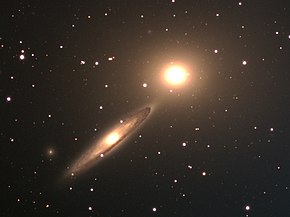NGC 5090 and NGC 5091
| NGC 5090 and NGC 5091 | |
|---|---|
 NGC 5091 (left) and NGC 5090 (right) | |
| Observation data (J2000 epoch) | |
| Constellation | Centaurus |
| Right ascension | 5090: 13h 21m 12.8s 5091: 13h 21m 17.7s |
| Declination | 5090: −43° 42′ 16.4″ 5091: −43° 43′ 10.8″ |
| Redshift | 5090: 0.01141±0.00007 5091: 0.01177±0.00048 |
| Heliocentric radial velocity | 5090: 3,420.93±20.98 5091: 3,528.86±145.10 |
| Distance | 5090: 50.37 ± 3.55 Mpc (164.3 ± 11.6 Mly) 5091: 51.85 ± 4.15 Mpc (169.1 ± 13.5 Mly) |
| Apparent magnitude (V) | 5090: 11.51 5091: 13.35 |
| Apparent magnitude (B) | 5090: 12.59 5091: 13.94 |
| Absolute magnitude (V) | 5090: −24.8 5091: −21.0 |
| Characteristics | |
| Type | 5090: E2 5091: Sb pec sp |
| Apparent size (V) | 5090: 2′.9 × 2′.4 5091: 1′.8 × 0′.5 |
| Notable features | Interacting galaxies |
| Other designations | |
| PGC 46618 / 46626, ESO 270-2 / 270-4, LEDA 46618 / 46626, 2MASX J13211286-4342168 / J13211859-4343244 | |
References: [1] | |
NGC 5090 and NGC 5091 are a set of galaxies approximately 160 million light-years (50 million parsecs) away in the constellation Centaurus.[1] They are in the process of colliding and merging with some evidence of tidal disruption of NGC 5091.[2]
NGC 5090 is an elliptical galaxy while NGC 5091 is a barred spiral galaxy.[1] The radial velocity of the nucleus of NGC 5090 has been measured at 3,185 km/s (1,979 mi/s), while NGC 5091 has a radial velocity of 3,429 km/s (2,131 mi/s).[2] NGC 5090 is associated with the strong, double radio source PKS 1318-43.[2]
One supernova has been observed in NGC 5090: SN 1981C (type unknown, mag. 14.5).[3]
See also
[edit]References
[edit]- ^ a b c "Results for object NGC 5090". NASA/IPAC Extragalactic Database. Retrieved 9 March 2019.
"Results for object NGC 5091". NASA/IPAC Extragalactic Database. Retrieved 9 March 2019. - ^ a b c "Galaxy pair NGC 5090 and NGC 5091". European Southern Observatory. 30 April 1999. Retrieved 9 March 2019.
- ^ Transient Name Server entry for SN 1981C. Retrieved 29 March 2023.
External links
[edit]- "Of Holes in the Sky and Pretty Galaxies" by the European Southern Observatory
- NASA Astronomy Picture of the Day: Seeing Through Galaxies (5 December 1997)
- NGC 5090 and NGC 5091 on WikiSky: DSS2, SDSS, GALEX, IRAS, Hydrogen α, X-Ray, Astrophoto, Sky Map, Articles and images
Text is available under the CC BY-SA 4.0 license; additional terms may apply.
Images, videos and audio are available under their respective licenses.
